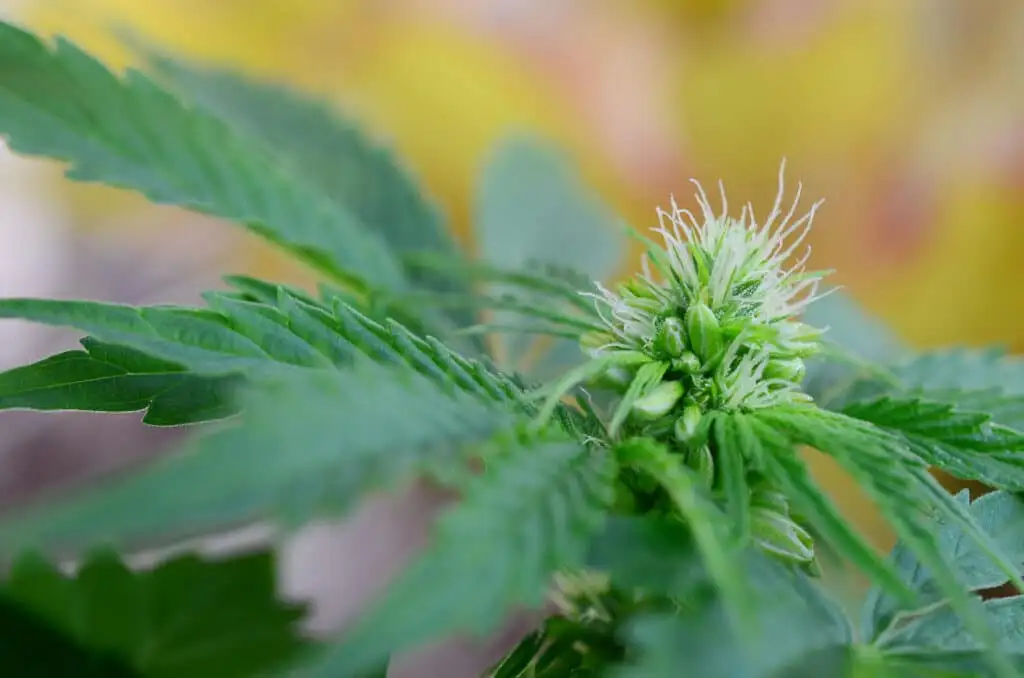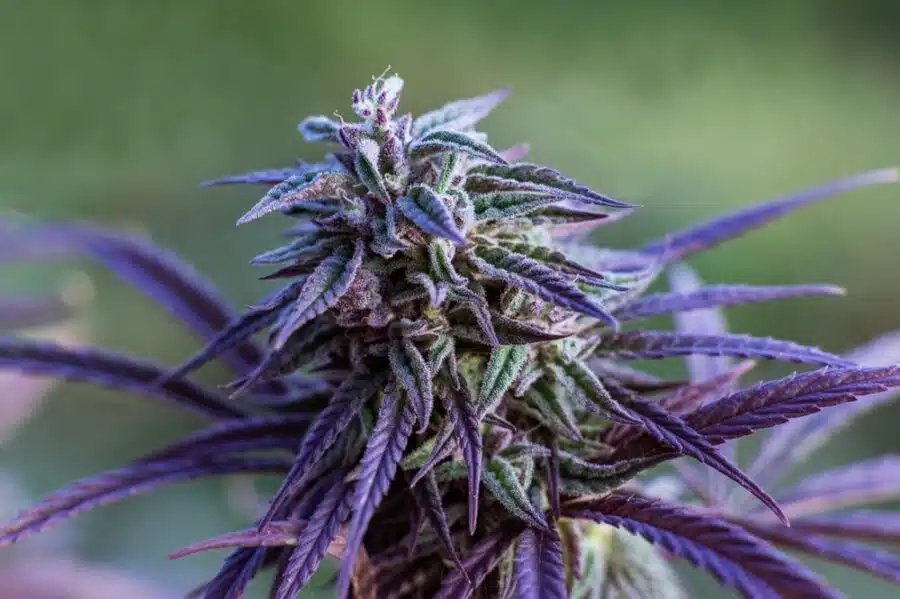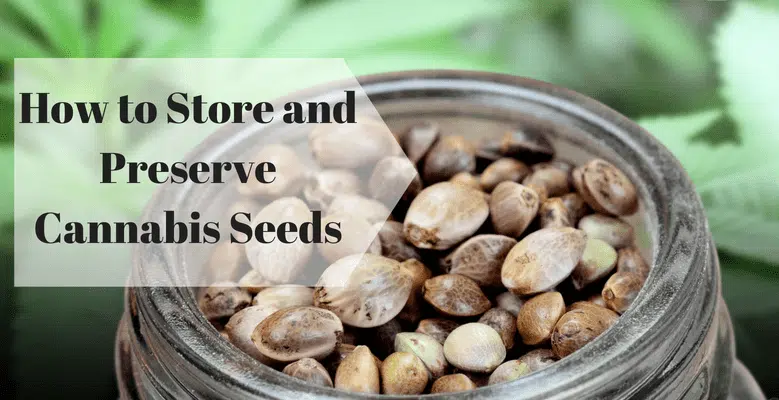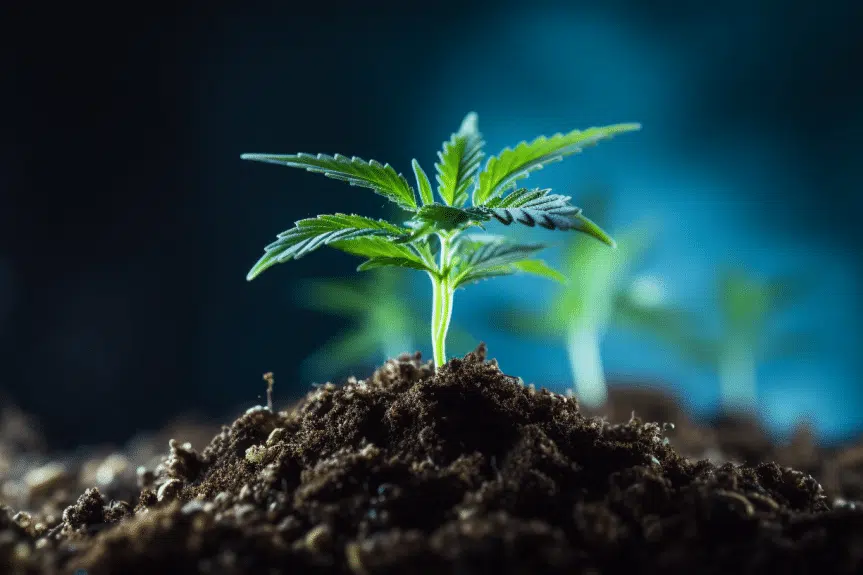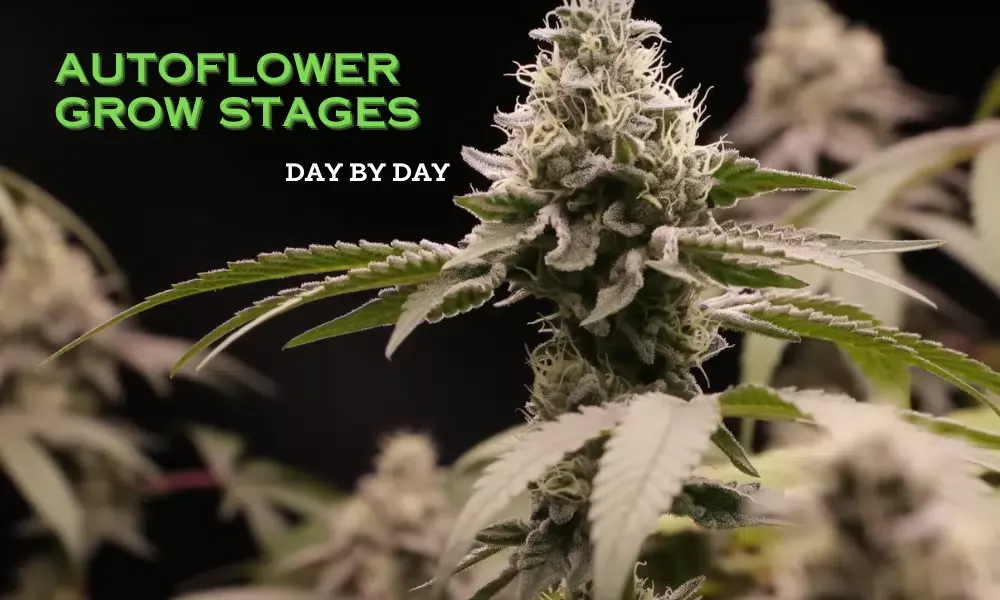Hermaphrodite Cannabis and How to Deal With It
Did you know that, like animals and humans, some plants can exhibit two reproductive organs in one? It’s rare, but hermaphrodite cannabis plants are real and could mean bad news if you’re growing marijuana for consumption.
So what is a hermie cannabis plant and how does it occur?
Join us as we investigate this anomaly, how to detect it, and what to do about it.
Let’s get started!
What is hermaphrodite cannabis?
Cannabis crops are classified as dioecious plants. This means that they contain either female flowers or male pollen sacs. An hermaphrodite plant exhibits both female and male traits. So, in these cases, you’ll find nodes with a bud site and others with pollen sacs on the same plant.
Typically, when growing cannabis from regular seeds, your plants would develop either male or female reproductive organs. Under ideal circumstances, the female plants would produce seeds and the males release pollen for reproduction.
Hermaphroditism isn’t necessarily a bad thing, unless you’re hoping to harvest dense, juicy buds. With both organs found on the same plant, you face the risk of self-pollination and it producing seeds in abundance.
This scenario means any buds produced by your marijuana plant will be of lower quality.
That’s if you harvest any buds.
What causes hermaphrodite plants?
There are two causes of hermaphroditism: genetic or environmental.
Genetically, some marijuana strains have a predisposition to hermaphroditism. The Blueberry and Gorilla Glue strains are notoriously known for their hermaphroditic tendencies.
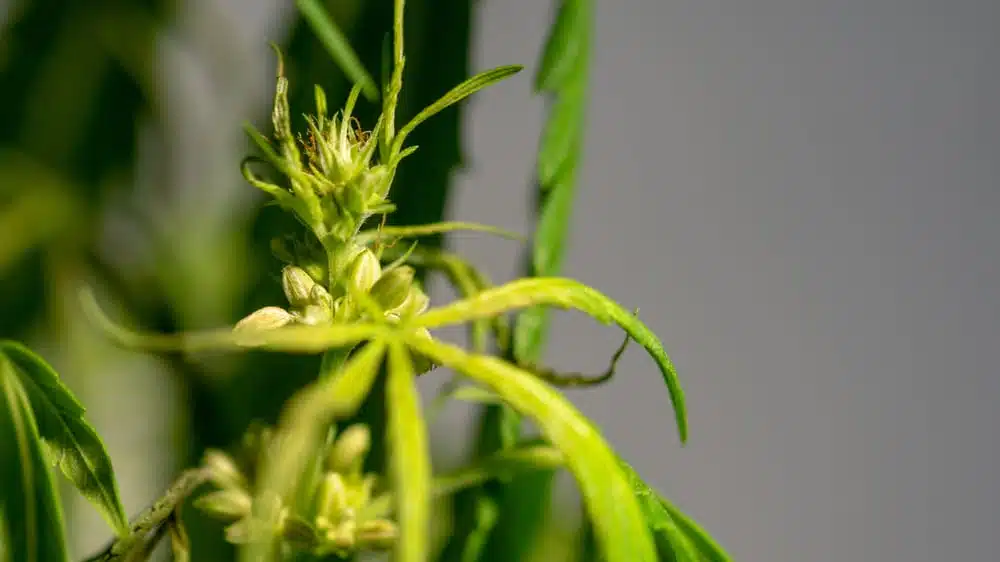
Of course, it’s not to say that every plant grown from these seeds will cause hermies, they just have a greater probability of occurring.
It’s also possible to cause hermaphrodite marijuana plants to develop through human or environmental intervention.
Some common influences include:
- Incorrect nutrient distribution: Different cannabis strains have specific growth requirements to reach their full potential and produce high-quality yields. One of the most important of these conditions includes meeting the plant’s nutritional requirements.
- Light stress: One of the main reasons behind hermaphroditism in female cannabis plants is stress during the flowering stage. The primary culprit for this stress? Light.It’s crucial to ensure that there are no light leaks in the grow room and that your cannabis plants receive an uninterrupted 12 hours of light and 12 hours of darkness.Another stressful factor to watch out for is light burn. Ensure that the lights are a safe distance from your crop to prevent damage.Outdoor growers should consider the environmental and additional factors like street lights and plan accordingly.
- Temperature fluctuations: We all know that cannabis plants need their specific requirements met in order to thrive. One of these requirements is an ideal temperature range of 68–77°F (vegetative stage) or 65–85°F (flowering stage).Extreme heat or cold could induce hermaphroditism in your cannabis plants.
- Incorrect training techniques: While high stress training and pruning could encourage better, healthier growth and increased crop yields when done efficiently. Excessive training stress, especially during the flowering stage, results in the plant trying to self-pollinate. To reach this goal, it’ll develop both female flower and male pollen sacs.
Other factors that may lead to a hermaphrodite cannabis plant are:
- Incorrect pH levels
- Insufficient water
- Incorrect fertilisation
- Incorrect humidity levels
- Diseases
- Pest infestation
By closely monitoring your flowering plants, you can detect possible stress triggers and adjust as required.
How to identify hermaphroditic weed plants
During cannabis cultivation, it’s crucial to follow the sexing procedure. Yes, even if you’re growing feminized plants. A female plant can develop male pollen sacs just as male plants could develop female sex organs when under stress.
The best time to determine your plant’s gender is during the preflowering stage, 3–6 weeks after germination.
To identify male and female plants, you need to look at the nodes found at the joints of the branches. Male cannabis plants display pollen sacs, which appear like tiny bunches of bananas, which release pollen.
Female cannabis plants develop their organs after around 4 weeks. While the female sex organs may look like the males’ at first, the calyx exhibits wispy white hairs. These white hairs are called the stigma form part of mature flowers.
An hermaphrodite marijuana plant displays both organs together. To spot the hermaphrodite characteristics in the initial flowering stages, cannabis growers should look out for the male and female structures at the nodes.
Some hermaphrodite cannabis plants may only display these characteristics at the end of their blooming period. This late display occurs when the plant is dying and tries to self-pollinate. So keep a close eye on your crop, ensuring that all needs are met.
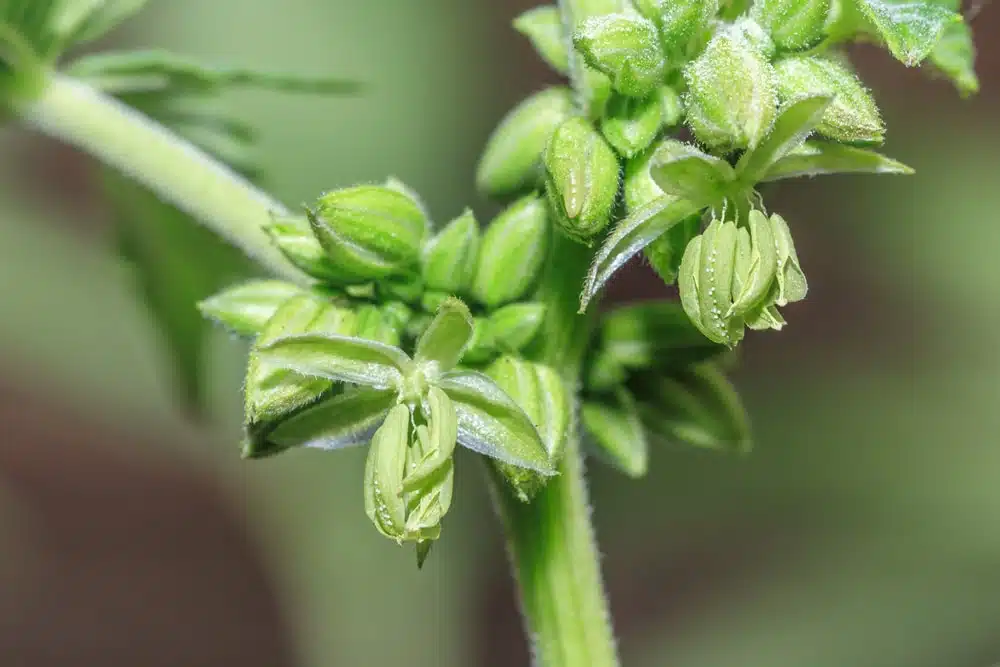
How to avoid hermaphrodite cannabis plants
As mentioned, some strains are predisposed to becoming hermaphrodite plants. For this reason, it’s vital to ensure that you have reliable information about the seeds you’re buying. Ensure that you thoroughly research your strain of interest based on genetics.
Also, ensure you purchase feminized cannabis seeds from reputable seed banks specializing in quality genetics, like The Seed Fair. Solid research on different strains ensures you also understand the specific requirements for selection. Such requirements include a favorable medium, soil type, pH level, etc.
Environmental factors are the next that you need to keep in check. Remember, if your cannabis plant is stressed, it’s likely to find a way to survive-which means turning into a hermaphrodite.
So keep a stress-free environment where your cannabis plants can thrive—keeping your crop happy means closely monitoring light cycles, temperature, humidity, etc. Ensure you don’t interfere with the plants’ dark stage and prevent light leaks at all costs.
Finally, ensure that nutrient deficiency, pathogens, and pests don’t threaten your crop. You can easily do this through close monitoring to act fast in case you note any of these.
Ensure that the flowering period and harvest time run within the recommended schedule. Delaying either of these could cause an hermaphrodite plant.
Ultimately, the best way to avoid hermaphrodite plants and ensuring high yields and potent buds is through close monitoring.
What to do with hermaphrodite cannabis plants?
All is not lost when you notice hermaphrodite signs on your crop. As you’d isolate male cannabis plants to prevent pollination, this is the first step for hermies. Do so cautiously to avoid shaking the plant and causing accidental pollination.
The next step is to perform a thorough snipping. Identify the sections of the male organs on the plant, then cut them off entirely. One way to do this is using sterilized tweezers to remove the pollen sacs.
A cannabis hermaphrodite crop isn’t the end of the world, though. The plant still has some valuable uses, like:
- Making cannabis concentrates: You can extract THC from the hermaphrodite weed to produce potent concentrates like tinctures, rosin, hash, and many more.
- Pollination and breeding: If you plan to breed and collect new cannabis seeds, allowing pollination is the way to go. To experiment with cross breeding, transfer the pollen to other female plants using a cotton bud or a small paintbrush.
Is hermaphrodite cannabis all that bad?
While hermaphrodite cannabis isn’t ideal, it certainly isn’t the end of the world for cannabis growers.
Of course, if you’re aiming to harvest glistening, trichome-rich buds for an epic consumption experience, then it’s best to avoid hermies. If a single male cannabis plant could pollinate your entire crop, resulting in lower-quality buds, then hermies pose the same risk.
The good news, however, is that there are still uses for hermaphrodite weed plants. You won’t necessarily harvest an epic yield of juicy buds, but all is not lost. Use the plant for extracts and other valuable uses.
Frequently asked questions
Cultivating cannabis seeds is a rewarding endeavor and shouldn’t be dampened by the appearance of hermaphrodites in your crop. If you still have a few uncertainties about how to handle this phenomenon, here are a few common questions to help.
When can I identify hermaphrodite traits?
As you’d identify and remove any male cannabis plant from your crop around 3–6 weeks after germination, the same applies for hermies. The male plant often develops its organs before the female, making vigilance vital to prevent pollination.
Are buds from hermie plants smokable?
While the answer is a simple yes, we should point out that you might not want to. Any buds produced by hermaphrodite weed plants are significantly lower quality than those from a 100% female plant. Seed production impacts the taste and overall smoking experience of these buds.
How do I prevent hermaphrodite cannabis plants?
Whether you have feminized or regular seeds, it’s essential to understand the strain and its specific growing requirements before you germinate. Ensure that you provide the ideal conditions for your chosen strain to help your marijuana plants thrive.
Extreme heat or cold, extended flowering, insufficient lighting and nutrients, and late harvest contribute to the stress that induced hermie development. Monitor the growing conditions carefully and ensure that your cannabis plants are harvested early to prevent stress.
Are hermaphroditic plants useful?
If you’re growing a crop with the purpose of breeding, the hermaphrodite cannabis plant can still fertilize the female flowers. These plants produce viable seeds and are especially helpful if you’re breeding new strains of weed.
The cannabis plants can also create products like tinctures, rosin, extracts, and more.
Can hermaphrodite marijuana produce buds?
Yes, it can. Though they have pollen sacs, the female aspect of the plant produces buds. We should emphasize, though, that these buds are highly inferior to those found on a regular female cannabis plant.

